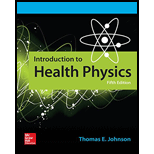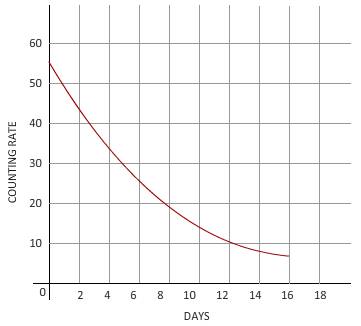
Concept explainers
To calculate:
The counting rates of
Answer to Problem 4.3P
Counting rates of
The equation of curve for count rate versus time is:
Explanation of Solution
Given Information:
Volume of solution
Activity of
Activity of
Duration
Formula used:
Graph of count rate versus time is as below:

We know that
While
Thus, total number of counts=
Hence, ratio of counts at t=0
Where,
For 131I
Where,
Decay activity of a solution is plotted on graph, by plotting count rate per second over a period of 16 days; we get a curve of total activity as a function of time.
The equation of the curve is a summation of activities of two components
Equation of curve of activity versus time is:
Conclusion:
We calculate the relation count rates over a period of 16 days for
And the corresponding equation of curve obtained by plotting counting rates per second over a period of 16 days is:
The equation is the addition of activities of
Want to see more full solutions like this?
Chapter 4 Solutions
Introduction To Health Physics
- Find the radiation dose in Gy for: (a) A 10-mSv fluoroscopic x-ray series. (b) 50 mSv of skin exposure by an α emitter. (c) 160 mSv of β– and γ rays from the 40K in your body.arrow_forwardIn a nuclear medicine scan with 99mTc (t/2 = 6hrs), the signal-to-noise ratioImage size for a 30 min scan was 50: 1 with an injected radioactive dose of1 mCi (3.7x107 decays per second). Assume images startedimmediately after injection. If the scan time was doubled to 60minutes with a starting dose of 1 mCi, what would the SNR value of the image now be?arrow_forwardEstimate the exposure rate 2 m from 4 Ci sources of 57Co,22Na,65Zn?Exposure Rate constant for 57Co=0.9 (R.cm2) / (hr.mCi)Exposure Rate constant for 22Na =12 (R.cm2) / (hr.mCi)Exposure Rate constant for 65Zn =2.7 (R.cm2) / (hr.mCi)arrow_forward
- A particular radioactive source produces 100. mrad of 2- MeV gamma rays per hour at a distance of 1.0 m. (a) How long could a person stand at this distance before accumulating an intolerable dose of 1.0 rem? (b) Assuming the gamma radiation is emitted uniformly in all directions, at what distance would a person receive a dose of 10. mrad/h from this source?arrow_forwardIf a patient receives a dose with an activity of 37.5 mCi of technetium-99m for cardiac imaging, how much radioactivity will be left in the patient’s body 72 hours after injection?arrow_forwardA particular radioactive source produces 100 mrad of 2-MeV gamma rays per hour at a distance of 1.0 m. (a) How long could a person stand at this distance before accumulating an intolerable dose of 1 rem? (b) Assuming the gamma radiation is emitted uniformly in all directions, at what distance would a person recieve a dose of 10 mrad/h from this source? dont provode hand written solutionarrow_forward
- The radionuclide 32P (T1/2 = 14.28 d) is often used as a tracer to follow the course of biochemical reactions involving phosphorus. (a) If the counting rate in a particular experimental setup is initially 3050 counts/s, how much time will the rate take to fall to 170 counts/s? (b) A solution containing 32P is fed to the root system of an experimental tomato plant, and the 32P activity in a leaf is measured 3.48 days later. By what factor must this reading be multiplied to correct for the decay that has occurred since the experiment began?arrow_forwardCalculate the dose in Sv to the chest of a patient given anx-ray under the following conditions. The x-ray beam intensityis 1.50 W/m2 , the area of the chest exposed is0.0750 m2 , 35.0% of the x-rays are absorbed in 20.0 kg oftissue, and the exposure time is 0.250 s.arrow_forwardCalculate the Equivalent Dose of 0.55 Gy resulting from an exposure to a 6 MV photon source. (WR=1)arrow_forward
- How many Gy of exposure is needed to give a canceroustumor a dose of 40 Sv if it is exposed to α activity?arrow_forwardA radioactive source is producing 1.50 MeV gamma rays. If two detectors are placed 4.00 m and 7.00 m away respectively, what is the ratio of the measured intensities of the near detector over the far detector (I2/I1)? Do NOT include units in your answer answer to 2 decimal places.arrow_forwardA medical researcher is using a chromium-51 source to study red blood cells. The gammaemissionintensity at a distance of 1.0 m is 0.75 mrem/s· m 2 .At what distance would the intensity drop to 0.15 mrem/s· m 2 ?arrow_forward
 Principles of Physics: A Calculus-Based TextPhysicsISBN:9781133104261Author:Raymond A. Serway, John W. JewettPublisher:Cengage Learning
Principles of Physics: A Calculus-Based TextPhysicsISBN:9781133104261Author:Raymond A. Serway, John W. JewettPublisher:Cengage Learning College PhysicsPhysicsISBN:9781938168000Author:Paul Peter Urone, Roger HinrichsPublisher:OpenStax College
College PhysicsPhysicsISBN:9781938168000Author:Paul Peter Urone, Roger HinrichsPublisher:OpenStax College Modern PhysicsPhysicsISBN:9781111794378Author:Raymond A. Serway, Clement J. Moses, Curt A. MoyerPublisher:Cengage Learning
Modern PhysicsPhysicsISBN:9781111794378Author:Raymond A. Serway, Clement J. Moses, Curt A. MoyerPublisher:Cengage Learning University Physics Volume 3PhysicsISBN:9781938168185Author:William Moebs, Jeff SannyPublisher:OpenStax
University Physics Volume 3PhysicsISBN:9781938168185Author:William Moebs, Jeff SannyPublisher:OpenStax



